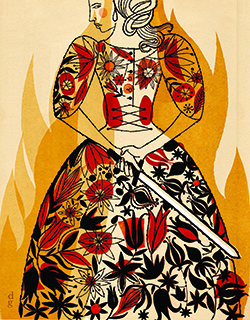Holidays
Hanukkah
Judith, Alternate Action Hero

Every year at Hanukka, I confront my own ambivalence about the holiday. Not only am I disturbed by its obvious ascendance as a consumer-focused counterpart to Christmas, I also do not find the Maccabees particularly compelling heroes.
Though I appreciate a good underdog story as much as the next Jew, I can’t get past the irony that we moderns so identify with the Maccabees in this story of traditionalists versus assimilationists. If we are honest with ourselves, we should admit that the Jewish Hellenists of the Hanukka story better represent contemporary American Jews.
So when I am seeking alternative insights into Jewish tradition, I often turn to the inspirational stories of women—and Hanukka offers a juicy one.
For centuries, Hanukka also celebrated the hero of the Book of Judith. Judith was a widow from the town of Bethulia, besieged by the Assyrian army. When the despairing Israelite leaders began to consider surrender, Judith rejected their fatalism and devised her own risky plan: She set out for the enemy camp and presented herself as a traitor to the Hebrews, gaining entrance to the tent of the Assyrian general Holofernes, where she plied him with food and drink until he passed out. Judith then took his sword, decapitated him and brought his head back to her own people, urging them to launch a surprise attack. In the absence of their leader, the Assyrian army was routed.
Though not included in the Hebrew Bible, the story of Judith has captured imaginations across the ages. In addition to blood, violence and a heroine at once pious and bold, beautiful and chaste, it—like the story of the Maccabees—offers the appealing theme of victory against the odds.
I am unsurprised that contemporary Jews have not rushed to reclaim this female hero wielding a sword and the head of the enemy—hers is hardly a gentle story. Yet it portrays a message relevant to modern Judaism: faith in the human role in pursuing justice.
Though Judith declares her devotion to God, she does not wait for a miracle but rather takes matters into her own hands. Even in praying for God’s help at the fateful moment, she asserts her own agency: “O Lord, God of all might, in this hour look graciously on the work of my hands for the exaltation of Jerusalem. Now is the time for aiding your heritage and for carrying out my design to shatter the enemies who have risen against us” (Book of Judith 13: 4-5). In declaring “the work of my hands” and “my design,” Judith’s story is ultimately not one of God’s salvation but of human courage and intervention.
Of course, this theme is also present in the story of the Maccabees, but it is often overshadowed by the theme of miracles and the anti-assimilationist message. The story of Judith makes a clear case for human action, and by putting that action in a woman’s hands, emphasizes that any person—even one who would traditionally not be considered leadership material—can be a liberator.
There is a time, to be sure, to look for miracles. But in our broken world, we would do better to cultivate our own bravery and our belief that we can be effective agents of change. For some of us, this agency is divinely inspired; for others, it is solely human in origin. Perhaps the real miracle of Hanukka is not that the oil burned for eight days but rather that even in times of oppression, our faith in the human ability to fight back has endured.
Judith Rosenbaum, Ph.D., is executive director of the Jewish Women’s Archive.










 Facebook
Facebook Instagram
Instagram Twitter
Twitter
Suzanne Somosi says
I have some bad news for you. The assimilationist Hellenizers that you so identify with haven’t been around for centuries. There are no Hellenistic Jews anywhere today. The assimilated American Jews are their spiritual descendants not their physical ones.
Please check your facts. The Assyrians defeated the Kingdom of Israel and exiled the 10 tribes, around 720 B.C.E. The Maccabees fought and defeated the Seleucids or Syrian Greeks under Antiochus IV around 165 B.C.E.